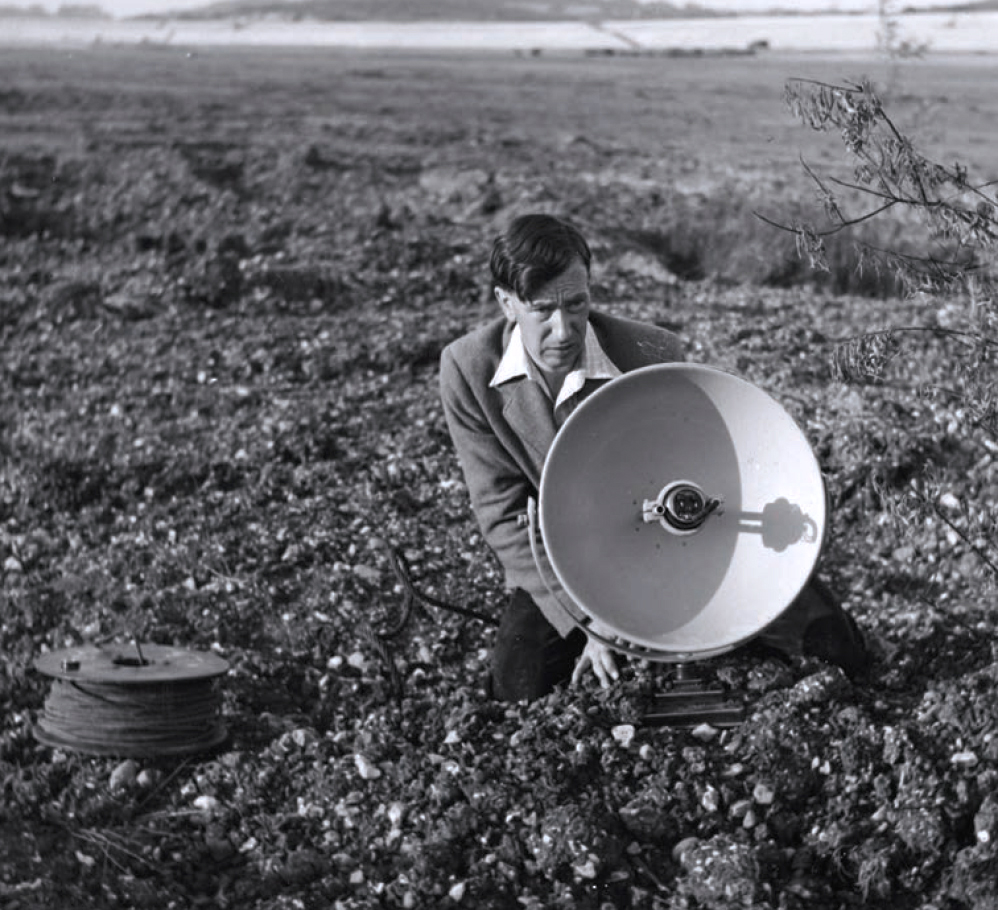
An early parabolic reflector being deployed in the field by Eric Simms, one of the pioneers of bird-sound recording in the 20th century.
33 : Parabolic reflector
1888

An early parabolic reflector being deployed in the field by Eric Simms, one of the pioneers of bird-sound recording in the 20th century.
A bird’s vocalisations can often be a feeble and mobile sound source, and therefore very difficult to record even with modern equipment, let alone with the first impractical recording machines which used cylinders (see pages 78–79). Clearly, a method had to be found to gather sound waves and concentrate them towards a microphone, in order to amplify the signal so that it could be isolated more efficiently from ambient background noise.
This idea had already been in use in optical design since the first telescopes were developed in the 15th century, using mirrors to concentrate light beams, but it took a German physicist named Heinrich Hertz to adapt the concept for sound waves. The first parabolic reflectors, essentially concave dishes with a microphone or receiver placed in a central focal point to gather the collected sound waves, were actually developed for radio waves, and most of the innovations were achieved as this technology grew.
Shotgun microphones, which only collect sound from sources directly in front of them, are the microphones of choice for most field recordists, but they only pick up loud, close sounds well. Parabolic reflectors eliminate much of the extraneous noise that may be present in the field, while isolating a particular bird’s song when pointing the device directly at the source, and amplifying and concentrating it; in effect, they are the audio equivalent of a telephoto lens on a camera. Stereo sound is difficult to achieve owing to the circular and limited catchment of a reflector, and an omni-directional microphone must usually be used. The largely high-pitched nature of bird sound means that they can be recorded relatively well by parabolic microphone set-ups, which usually have a poor bass frequency response.
The first known use of a parabolic microphone set-up for wildlife recording came some 44 years after the invention of the reflector itself. In 1932 Peter Paul Kellogg, a professor at Cornell University, New York, used a somewhat “crude, awkward, bulky ‘dish’” to make a field recording of a singing Yellow-breasted Chat onto the soundtrack of a film, ‘optical’ recording having already become a standard medium at the college. He and his colleagues experimented with different weights, sizes, focal lengths and materials, and used theoretical data already published in physics papers two years previously to refine their techniques.
Technological advancements like directional microphones have meant that the principles of parabolic recording techniques no longer require a large reflecting dish, but the demands of amateur practitioners at least mean they are still often used by wildlife sound recordists. Well-designed plastic reflectors have also been marketed for the emptier pocket, and can produce very good results. Reflectors, or microphone kits incorporating their principles, are still in constant use in wildlife film-making and sound recording.